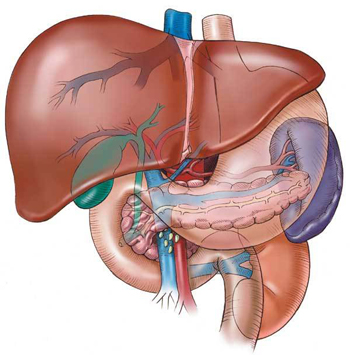Among the most common liver diseases are cholecystitis (inflamed gallbladder) and hepatitis. Cholecystitis is a disease that mainly affects women aged between 20 and 50 years, and can occur either as a result of infectious jaundice, constipation or appendicitis let untreated. But there are many patients suffering from cholecystitis without having any of the problems mentioned above. For these, the main cause of liver disease it’s a diet high in fat and especially fried foods.
Irritation of fried foods produced in the stomach will prevent the gall bladder emptying in time, causing the bladder inflammation due to microbial penetration (constant discharge prevents the growth of microbes entered the gallbladder).
The first symptoms are localized pain occurring on the right under the edge of the ribs, nausea, vomiting, fever. Crises often occur after meals high in fat or by grief. Untreated in time, cholecystitis worsens, and gallstones can occur (stones).
The stones are formed from cholesterol, arising from the changing composition of bile, in the beginning is small, but as time went on became increasingly higher. Stones can cause crisis, or may remain in the bladder until it can not fulfill its function. In this case, the gallbladder should be removed (cholecystectomy).
Hepatitis is another serious condition of the liver that occurs as a result of viral infections that affect the entire body especially the liver. The most common types of hepatitis are denoted by letters A to E.
Hepatitis A is caused by hepatic virus A and is also called epidemic hepatitis because occurs in outbreaks, affecting mainly children. It is transmitted by direct contact with sick persons or infected food and water.
Hepatitis B is a disease more severe than hepatitis A, hepatitis B is transmitted through infected blood transfusions, through contaminated needles, or from improper handling of ustensils in cosmetic salons by causing damage to the epithelial. Can also be transmitted through dental maneuvers. Proper sterilization and use of disposable utensils prevent spread of the virus. Transmission is also made through unprotected sex and as well as from mother to fetus. In case of hepatitis B vaccination against hepatitis B virus can be made.
Hepatitis C virus (HCV) is responsible for about 80% of the chronically ill persons. In most cases this evolve into chronic hepatitis C cirrhosis and liver cancer. Transmission is through infected blood transfusions, unprotected sexual contact, from mother to fetus, sporadic transmission using sterile utensils that can cause bleeding. There are currently no vaccine against hepatitis C virus.
